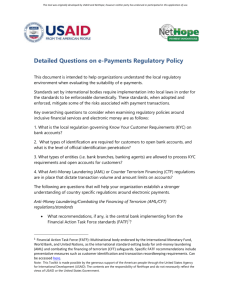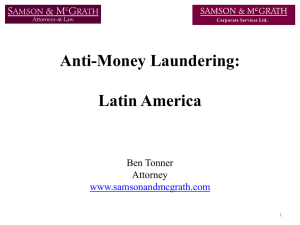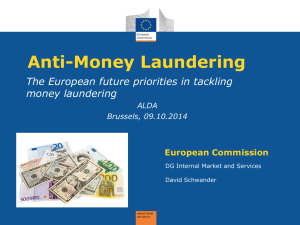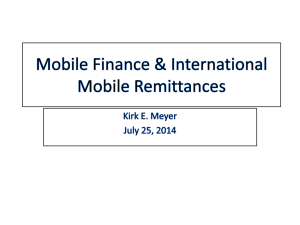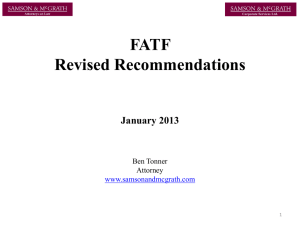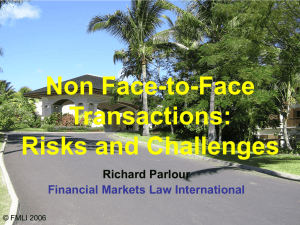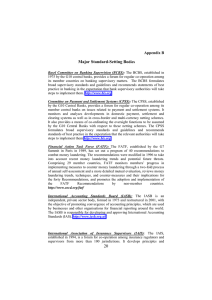Proceedings of 10th Asia - Pacific Business and Humanities Conference
advertisement
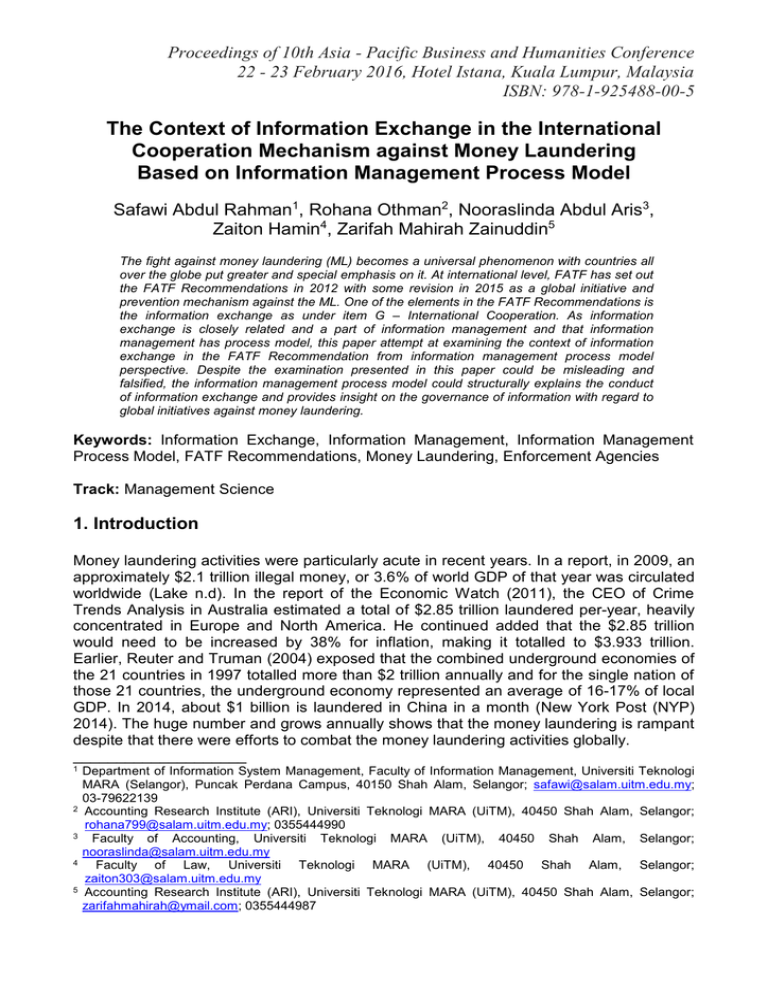
Proceedings of 10th Asia - Pacific Business and Humanities Conference 22 - 23 February 2016, Hotel Istana, Kuala Lumpur, Malaysia ISBN: 978-1-925488-00-5 The Context of Information Exchange in the International Cooperation Mechanism against Money Laundering Based on Information Management Process Model Safawi Abdul Rahman1, Rohana Othman2, Nooraslinda Abdul Aris3, Zaiton Hamin4, Zarifah Mahirah Zainuddin5 The fight against money laundering (ML) becomes a universal phenomenon with countries all over the globe put greater and special emphasis on it. At international level, FATF has set out the FATF Recommendations in 2012 with some revision in 2015 as a global initiative and prevention mechanism against the ML. One of the elements in the FATF Recommendations is the information exchange as under item G – International Cooperation. As information exchange is closely related and a part of information management and that information management has process model, this paper attempt at examining the context of information exchange in the FATF Recommendation from information management process model perspective. Despite the examination presented in this paper could be misleading and falsified, the information management process model could structurally explains the conduct of information exchange and provides insight on the governance of information with regard to global initiatives against money laundering. Keywords: Information Exchange, Information Management, Information Management Process Model, FATF Recommendations, Money Laundering, Enforcement Agencies Track: Management Science 1. Introduction Money laundering activities were particularly acute in recent years. In a report, in 2009, an approximately $2.1 trillion illegal money, or 3.6% of world GDP of that year was circulated worldwide (Lake n.d). In the report of the Economic Watch (2011), the CEO of Crime Trends Analysis in Australia estimated a total of $2.85 trillion laundered per-year, heavily concentrated in Europe and North America. He continued added that the $2.85 trillion would need to be increased by 38% for inflation, making it totalled to $3.933 trillion. Earlier, Reuter and Truman (2004) exposed that the combined underground economies of the 21 countries in 1997 totalled more than $2 trillion annually and for the single nation of those 21 countries, the underground economy represented an average of 16-17% of local GDP. In 2014, about $1 billion is laundered in China in a month (New York Post (NYP) 2014). The huge number and grows annually shows that the money laundering is rampant despite that there were efforts to combat the money laundering activities globally. ____________________ 1 2 3 4 5 Department of Information System Management, Faculty of Information Management, Universiti Teknologi MARA (Selangor), Puncak Perdana Campus, 40150 Shah Alam, Selangor; safawi@salam.uitm.edu.my; 03-79622139 Accounting Research Institute (ARI), Universiti Teknologi MARA (UiTM), 40450 Shah Alam, Selangor; rohana799@salam.uitm.edu.my; 0355444990 Faculty of Accounting, Universiti Teknologi MARA (UiTM), 40450 Shah Alam, Selangor; nooraslinda@salam.uitm.edu.my Faculty of Law, Universiti Teknologi MARA (UiTM), 40450 Shah Alam, Selangor; zaiton303@salam.uitm.edu.my Accounting Research Institute (ARI), Universiti Teknologi MARA (UiTM), 40450 Shah Alam, Selangor; zarifahmahirah@ymail.com; 0355444987 Proceedings of 10th Asia - Pacific Business and Humanities Conference 22 - 23 February 2016, Hotel Istana, Kuala Lumpur, Malaysia ISBN: 978-1-925488-00-5 Money laundering is one of global phenomenon that became acute lately. At the international level therefore, governments all around the world have enhanced the cooperation in fighting money laundering through various multilateral forums and associations to curb these activities. The Financial Action Task Force (FATF) as an international inter-governments bodies to combat money laundering have consistently setting standards and promoting effective implementation of legal, regulatory and operational measures for combating money laundering, terrorist financing and the financing of proliferation, and other related threats to the integrity of the international financial system since 1989. Most recently, the FATF Recommendations (FATF 2012; 2015) has been introduced as a comprehensive guideline in the fight against money laundering to be implemented by FATF countries and regional members. The FATF Recommendations include main 7 sections namely; A – AML/CFT Policies and Coordination B – Money Laundering and Confiscation C – Terrorist Financing and Financing of Proliferation D – Preventive Measures E – Transparency and Beneficial Ownership of Legal Persons and Arrangements F – Powers and Responsibilities of Competent Authorities and Other Institutional Measures G – International Cooperation Section G - International Cooperation1 includes a recommendation read “Other forms of international cooperation” i.e. Recommendation #40 that deals heavily with information exchange. The inclusion, as one can perceive is due to the criticality of information as a basis for decision making and problem solving. In the ML context, the necessary information is required as to plan and act (decision making and problem solving) against money launderer. Information exchange among FATF members then become a mechanism to share the information about potential ML threats. Further, the information exchange intended by Recommendation #40 is defined to cover items (a) facilitating access by foreign competent authorities to any information held by registries or other domestic authorities; (b) exchanging domestically available information on the trusts or other legal arrangement; and (c) using their competent authorities’ powers, in accordance with domestic law, in order to obtain beneficial ownership information on behalf of foreign counterparts (FATF 2012; 2015 pp 90). The emphasis on information as narrated in the FATF document implies that the success of the fight against ML would much depend on the proper conduct of information exchange. Information exchange provides theoretical and technical approaches that describe the process of reciprocal giving and receiving information between the actors across the locations with purpose (Laudon & Laudon 2002) and is a process centric activity within contexts (Xie 2013). To one extent, a proper management of information appropriate for decision making and problem in any context could also be studied or viewed from information management perspective. Information management is another mature field of study supporting organizations in making strategic decision making. Hence, information exchange and information management share similarities in many aspects 1 Section G - International Cooperation includes 5 recommendations namely a) International instruments, b) Mutual legal assistance, c) freezing and confiscation, d) Extradition and e) Other forms of international cooperation in Recommendations #36 through #40 respectively. Proceedings of 10th Asia - Pacific Business and Humanities Conference 22 - 23 February 2016, Hotel Istana, Kuala Lumpur, Malaysia ISBN: 978-1-925488-00-5 such as the goal and the process. As a process centric, information exchange is perceived to contain structured processes leading to the success of a particular occurrence or issue. Therefore, to some extent, information exchange can be taken as part of information management duo that from process model view, the exchange or sharing of information is critical part of information management. This paper attempts at elucidating the information exchange in general and in the context of FATF Recommendations in particular following information management process model perspective. In doing this, the FATF Recommendations #40 (FATF 2012; 2015) briefly explain in this section and the Malaysian Mutual Evaluation Report (FATF & APG 2015) serve the input as information exchange. The specific contexts of information exchange detailed out and derived from the two serving documents would be matched to the information management process. It is expected this matching would let public and readers to realize the place of information criteria stated in the documents from the information management process model perspective. Even though the matching and placement could not appropriate as they should be, at least they trigger an insight of how information exchange can be assimilated into information management process model. The following outline is applied in presenting the idea contained in this paper. Next section briefly presents the concept of information management with emphasis on its process model. The following section will elaborate the FATF’s information exchange and the scope it covers. The mapping of information exchange and the information management process model and the associated discussion are in section 4. Section 5 concludes the paper with some further directive insights. 2. Information Management and Information Management Process Model This section reviews information management subject. The final aim of the review is to provide the foundation of the process model of information management. This process model will later be tabulated against the element of information within the good governance area. The tabulation aims at showing that the process model of information management structurally supports the information processing of good governance and therefore, it could also be a mechanism in fighting the many laundering activities. IM is mature field study. It is a term that has various concepts and interpreted differently by different constituencies and is used interchangeably with other terms like management of resources, information technology (IT), or policies and standards (Choo 2012; Ohairwe 2014). Generally put, IM is a discipline of study that concerns with “supporting the delivery of information to the organisation to be used for business purposes and with working with others to ensure this delivery” (Information Management Team 2014). The Department of Defence of Australian Government (DoD-AG) (2010) defines IM as getting the right information to the right person at the right time to enable him/her to make the right decision. It has been identified as an important area in which its contribution can ensure organizational success and effectiveness (Abdul Karim & Hussein 2008). As in the study of other disciplines, the study of IM also has some intended goal. The general goal of IM is to ensure the right information is available to the right person, in the right format at the right time. However, the specific goal of information management, as Proceedings of 10th Asia - Pacific Business and Humanities Conference 22 - 23 February 2016, Hotel Istana, Kuala Lumpur, Malaysia ISBN: 978-1-925488-00-5 acknowledged by Detlor (2009) is to help people and organizations access, process and use information efficiently and effectively. Doing so helps organizations operate more competitively and strategically, and helps people better accomplish their tasks and become better informed. Detlor (2009) further added that a variety of information resources are managed by organizations. These include transactional information stored in databases, summarized information found in data warehouses, and unstructured information content found in documents and reports. Thus, in a nutshell, this goal deals with the management of all information processes involved in the information lifecycle with the goal of helping an organization reach its competitive and strategic objectives. IM can also be viewed from process model since it has some structured activities that can be instantiated. A large number of scholarly definitions are available in explaining IM as a process model. Most recently, the Information Management Strategy Alberta (IMSA) (2013) acknowledges that IM is the way in which an organization plans, identifies, captures, manages, preserves and disposes of its information across all formats, (physical and digital), and includes the management of all functions associated with information, such as security, metadata management, quality management and etc. Choo (2002) combines important aspects of information management in relation to decision making and claims IM to contain identification of user needs, information acquisition/gathering, organization and storage, processing, distribution and use. Grenfell (2011) defines IM as “the economic, efficient and effective coordination of the production, control, storage, retrieval and dissemination of information from external and internal sources, in order to improve performance of the organization”. Detlor (2009) states that IM is the management of the processes and systems that create, acquire, organize, store, distribute, and use information. As for Rad, Shams & Naderi (2009), IM refers to planning, organizing, directing and controlling information within an open system, and the use of technology and techniques for effective management of information and knowledge resources and assets within the organizational internal and external environment to gain competitive advantage and to improve performance. The variety of processes in those definitions is depicted in Table 1 for ease of the understanding and discussion in the coming sections. Plan Table 1: Listing of IM Process Model Rad, Shams Grenfell Detlor & Naderi (2011) (2009) (2009) Production Create Planning Identify Capture Control Storage Acquire Organize Organizing Directing Manage Preserve Dispose Retrieval Dissemination Store Distribute Use Controlling IMSA (2013) Choo (2002) Identification of user needs Acquisition Organization and Storage Processing Distribution Use This paper looks mainly at IM from this process model perspective. All models in Table 1 can be referred and used as platform for examining any particular subject of interest with regard to information management. However, this paper considers Choo’s (2002) process model (in the 5th column of Table 1) as point of reference for further discussion. The consideration is due to its maturity, comprehensiveness and prominence of its process Proceedings of 10th Asia - Pacific Business and Humanities Conference 22 - 23 February 2016, Hotel Istana, Kuala Lumpur, Malaysia ISBN: 978-1-925488-00-5 model. Consequently, the process model of identification of information needs, information acquisition, information organization and storage, information distribution and information use would be adopted as the point of reference for discussing the information exchange among the international enforcement bodies discussed in later section. According to Choo (2002), the identification of information needs means that organization members recognize the volatility of information and seek information about salient features in order to make sense of the situation, and to have the necessary information to take decisions and solve problem (pp 24). As for the information acquisition, he states that it is driven by and must adequately address the information needs. He further added that existing sources have to constantly evaluated, new sources have to be assessed and the matching of sources to need has to be regularly re-examined (pp 24). The information organization and storage, according to him is to create an organizational memory that is the active repository of much of the organization’s knowledge and expertise. The volume of data produced and collected needs to be given structure in ways that reflect the interest and information-use modes of the organization and its members (pp 24-25). Information distribution is the sharing of information. The widespread information sharing catalyses organizational learning and creates new insight and knowledge about difficult problems or situations (pp 25). Finally, information use is for creation and application of knowledge through interpretive and decision making process in which interpretive includes social construction of reality and decision making involves the selection of alternatives (pp 25). Figure 1 illustrates the Choo’s (2002) information management process model. Information Needs Information Acquisition Information Organization & Storage Information Distribution Information Use Figure 1: Information Management Process Model Adopt from Choo (2002) 3. Information Exchange and Information Management Information exchange (IE) is another broad term generally used loosely to describe the information sharing in contextual manner. However, as another mature area of study, information exchange has had a firm conception in both theoretical and practical setting. Information exchange is defined as provisions to conduct joint research, investigations, and assessments which include, or could be inferred to include, some aspects of data and information exchange (Gerlak, Lautze & Giordano 2013). The Cambridge Dictionaries Online (2016) defines information exchange as the act of people, companies, and organizations passing information from one to another, especially in electronically or in a system forms. In the practical setting, Gerald & Graneli (2013) described IE as a way of getting closer to a situation. Earlier, Katungi, Edmeades & Smale (2006) defined IS as any form of information sharing. IE or information exchange requirement (IER) is the description, in terms of characteristics, of the requirement to transfer information between two or more end users (Suzic & Yi 2008). The study on IE takes different forms and contexts. In the literature, IS was studied either in the technical, system and communication setting such as in Pawar (2004), Cambini, & Valletti (2005), Suzic & Yi (2008) and many other scholars. It also been studied in the Proceedings of 10th Asia - Pacific Business and Humanities Conference 22 - 23 February 2016, Hotel Istana, Kuala Lumpur, Malaysia ISBN: 978-1-925488-00-5 conceptual and managerial basis such as in das Nair & Mncube (2012), International Centre for Migration Policy Development (ICMPD) (2010), Katungi, Edmeades, & Smale (2006) and Gerard & Granelli (2013). The quite a lot number of studies on IE imply that this particular subject could result in large efficiency benefits (das Nair & Mncube, 2009). Generally, IE is concerned with acquisition of information from one source to another and vice versa. In information process model, as depicted in Table 1, acquisition, capturing or acquiring is one of the process in managing information for strategic purposes. In this way, this paper posits that IE and IM relates with each other and IE is critical part of information management greater subject. In the context of this paper, IE is deemed importance as it has been considered as beneficial mechanism for fighting ML together with other mechanism such Acts (national and international), international agreement (bilateral or unilateral), international forums and etc. The following section further discusses the IE and its relationship with FATF Recommendations as to alert how IE in the FATF Recommendations suits information management process model. 4. Information Exchange in the FATF Recommendations (Global Initiatives) The interpretive note to recommendation #40 comes to refine and define the item “Other forms of international cooperation” under section G – International Cooperation of the FATF Recommendations. The interpretive note for this subsection list down two main principles in which each principle contains respective items summarized in Table 2 below. As under the second principle read “Principles applicable to specific forms of international cooperation”, all items are about guideline for information exchange among enforcement agencies at global context. This paper notes that the all guidelines under this second principle are explained in general form. The details of these guidelines are interpreted in the Mutual Evaluation Report (MER) by individual countries that are produced from and based on the main FATF Recommendations. In Malaysian context, the principles are refined in the Malaysia MER 2015 (FATF & APG 2015). As such, Table 2 represents the refinement of guideline for each item listed under principle #B. Table 2: Interpretive Notes for Recommendation #40 No. Interpretive Note Note Details A. Principles applicable to all forms of international cooperation Recommendation #40 Other Forms of International Cooperation B. Principles applicable to specific forms of international cooperation Criteria a. Obligations on requesting authorities b. Unduly restrictive measures c. Safeguards on information exchanged d. Power to search for information a. Exchange of information between FIUs b. Exchange of information between financial supervisors c. Exchange of information between law enforcement authorities d. Exchange of information between non-counterparts Proceedings of 10th Asia - Pacific Business and Humanities Conference 22 - 23 February 2016, Hotel Istana, Kuala Lumpur, Malaysia ISBN: 978-1-925488-00-5 In Table 2, both principles (A & B) emphasize the principles of international cooperation, however principle B fully defining the criteria of the information exchange (a through d) in supporting the intended other types of international cooperation. In the main FATF Recommendations (FATF 2012; 2015) document, the guiding principles of each these criteria has been narrated. However, no special conducts are offered on how and what/which pieces of information involved and who will be responsible in administer the exchanging of the information. The refinement comes in another respective document namely in Malaysia Mutual Evaluation Report (MER) (FATF & APG 2015). 4.1 The Scope Information Exchange in Malaysia Mutual Evaluation Report (MER) The Malaysian Mutual Evaluation Report (MER) (FATF & APG 2015) is the document that spelled out and interpreted the FATF Recommendation (FATF 2012; 2015) aligned with local nature. All requirements relating to the principles set forth in criteria a through d of the B principle’s detail in Table 2 are appropriately defined in Criterion 40.9 through Criterion 40.20 on page 201 through 203 in Malaysia MER document. This paper notes that the excerpts presented herein are excerpts that contained the keywords tailored around the scope of information exchange as the aim of the paper is to match the scope of information exchange with the information management process model. The phrases and excerpts those are not containing any scope of information exchange have not included in this simple analysis. Table 3: The Description of Criteria of Malaysia MER and the scope of Information Exchange Criteria Description of Criteria Scope Criterion 40.9 - AMLA provides for sharing information with foreign counterparts on ML, TF and similar offences. This extends Sharing to cover predicate offences through s.29(3) and s.10 of the AMLA Exchange of information between Criterion 40.11 – Sections 10 and 29(3) provide broad powers for Exchange; FIUs the FIU to exchange all information required to be accessible by Access; the FIU and all other information which the FIU has the power to Obtain obtain or access. Criterion 40.12 - BNM: The strict secrecy conditions on information relating to the affairs or account of any customer of an FI continue in the new banking laws introduced in 2013. Schedule 11 to the FSA and IFSA permits the disclosure of information to a Disclose relevant supervisory authority outside Malaysia, but such disclosure is restricted to information relating to branches and subsidiaries of foreign financial entities as provided under s.134of the FSA. Criterion 40.12 (a8.62) The analysis of secrecy provisions Exchange of affecting LFSA is set out at R.9 above and highlighted minor Obtain; Share information between limitations on LFSA’s ability to obtain and share the widest range financial supervisors of information. Criterion 40.13 - BNM: Sections 153 of the FSA and 165 of the IFSA permits disclosure of information to a relevant supervisory authority outside Malaysia which exercises functions Disclosure; corresponding to those of BNM. In addition, s.40(1)(b) of the CBA Obtain; Share empowers BNM to obtain any information or share any information with any supervisory authority. Criterion 40.13 - LFSA: The ability to provide information to Provide foreign counterparts in certain circumstances is set out in the Proceedings of 10th Asia - Pacific Business and Humanities Conference 22 - 23 February 2016, Hotel Istana, Kuala Lumpur, Malaysia ISBN: 978-1-925488-00-5 Exchange of information between LEAs Exchange of information between non-counterparts LFSAA. These provisions do not cover the exchange of all information domestically available to LFSA. Criterion 40.14 - BNM is able to share comprehensive information related to AML/CFT and prudential supervision of FIs and financial groups. BNM follows the Basel Core Principles and is able to share the required regulatory information, prudential information and detailed AML/CFT information without attracting the secrecy provisions of Malaysian laws. Criterion 40.14 - LFSA: LFSA’s ability to share information is limited to sharing information related to an individual Labuan FI with a home supervisor of a Labuan FI, and sharing information though the IOSCO and ESMA MMOUs and its 10 bilateral MOUs. Criterion 40.16 - BNM: Section 40(2) of the CBA requires that the sharing of information and documents with the foreign supervisor is subject to an undertaking for protecting the confidentiality of such information and the purposes for which it shall be used. Criterion 40.16 - SC: S.148 of the SCA imposes a duty of secrecy on the SC and all of its officers and staff, which would cover information obtained from other supervisors. Criterion 40.16 - LFSA: The requirement to have the prior authorisation of a counterpart before any dissemination of information provided by that counterpart is provided for in MoUs LFSA has entered into. Criterion 40.17 - Malaysia has provided details on mechanisms in which its LEAs and related competent authorities can share and cooperate with their foreign counterparts whereby the RMP has mechanisms in place to exchange domestically available information with its foreign counterparts, specifically relating to ML, associated predicate offences and TF including the identification and tracing if the proceeds and instruments of crime. Criterion 40.18 - During the onsite visit Malaysia demonstrated that LEAs are able to use their powers including investigative techniques in accordance to domestic law, to conduct inquiries and obtain information. Criterion 40.20 - There are no express provisions preventing competent authorities from exchanging information indirectly with non-counterparts. Such information exchange is facilitated through regional or international cooperation platforms or bilateral agreements. Share Share Share, Protect Obtain Dissemination Exchange Inquiry; Obtain Exchange The extraction of the scope of information exchange produces keyword results as in column “Scope” on Table 3. Note that some of the descriptive scopes are repetitive in that some keyword of scopes used for different criteria and can be generalized into Access, Disclose, Dissemination, Exchange, Inquiry, Obtain, Protect, Provide and Share when alphabetically arranged. This means that despite the criteria are numerous, the scope could be limited. Such limitation implies that the scope may not align with necessary information management processes or it is inadequate to be aligned with the rich and enormous processes model of information management. Next section discusses and analyses the scope of information exchange derived herein with mapping into information management process model. The mapping or matching is to realize the place of those scopes in the large spectrum of information management processes. Proceedings of 10th Asia - Pacific Business and Humanities Conference 22 - 23 February 2016, Hotel Istana, Kuala Lumpur, Malaysia ISBN: 978-1-925488-00-5 5. Discussion The nine scopes of information exchange derived from the document analysis presented on Table 3 in earlier section are brought into discussion in this section. To facilitate the discussion on the fitting the IE scope of process into IM process model and process index, the simple setup illustrated in Figure 2 is designed. The left layer in the horizontal manner is prepared for information management process model. The middle layer is the index layer ready for any process input. The right layer provided for the scopes or process of information exchange traced from FATF documents. Figure 3 is the extension and the complete view of visual analysis and showing how the index layer occupied and matched both information management process model and scopes of information exchange. Information Management Process Model Index Information Exchange Scope/Process IM Process 1 Process 1 IE Process 1 IM Process 2 Process 2 IE Process 2 ..... ..... ..... Figure 2: The Setup for Mapping IE and IM Process Model Information Management Process Model Process Index Information Exchange Scope/Process Information Needs Process #1 ? Information Acquisition Process #2 Access; Inquiry; Obtain; Provide Information Organization & Storage Process #3 Protect Information Distribution Process #4 Dissemination; Disclose; Exchange; Share Information Use Process #5 ? Figure 3: The View of Mapping IE into IM Process Model and Process Index Figure 3 illustrates the complete visual of the fitting IE scopes/process into process index and IM process model. As for IM process model on the left layer, all indexes are fulfilled and as seen, the processes are well arranged in sequence. In this mapping, the descriptive IE scopes with similar meaning are grouped into one particular index as it does Proceedings of 10th Asia - Pacific Business and Humanities Conference 22 - 23 February 2016, Hotel Istana, Kuala Lumpur, Malaysia ISBN: 978-1-925488-00-5 for IM process model. For example, the scopes of access, inquiry, obtain and provide have the same meaning and as a consequence, they are grouped into one similar process at Process #2 index. This way goes to scope of protect and dissemination, disclose, exchange and share in which they are into two groups respectively as depicted in Figure 3. Upon reconciling and fitting, two grey rectangles on the right hand layer are observed for Process #1 and #5 index. This implies that the arrangement of IE scopes/processes is not in an appropriate sequence. Many interpretations can be hypothesized from this circumstance with respect to the conducts of IE as learnt 2 from FATF documents specified for international cooperation on tackling ML issue. However, this paper escapes from narrating the hypotheses into the write up in this discussion due to ethical concerns. Moreover, this paper’s concern is on examining the conducts of information exchange in the FATF Recommendation from information management process model perspective. In so far, this paper has achieved its objective by its finding shown in the Figure 3 in that information exchange has been exercised by enforcement agencies as reported in Malaysia MER (FATF & APG 2015 pp 201-203). However, if viewed from process model, the conducts of information exchange seems not in complete manner due to that there is some “hole” in the information sources (document types, descriptions and etc.) to be exchanged and the way the shared information is or will be used by the recipients. 6. Conclusion This paper presents an initial examination on the context or scope of information exchange as a mechanism in fighting the money laundering as outlined in the FATF Recommendations and refined in the Malaysia MER 2015. The examination is based on and benchmarked over the information management process model. The result yields that the exchange of information has been partially and contextually implemented. The information exchange subject investigated and reported in this paper has a research merit in the context of management science with respect to the role of information as a basis for decision making and problem solving in money laundering issue in particular. Triggered by this initial examination, this paper recommends a further empirical investigation on the process of information exchange exercised in the local agencies that involved in and cooperated with international bodies regulating money laundering issue. The empirical investigation can be made available in the form of qualitative study that focuses on actual processes and scopes of information exchange. The process/scope gaps depicted in Figure 3 can be justified from this empirical study. This initial investigation also triggers another research initiative in exploring the practices of information management in enforcement agencies in Malaysia. This further exploration is to identify whether the information management principles have been satisfactorily exercised in the enforcement agencies. The focus should be given to both application of information management and the supportive technological infrastructures available within the departments. The result of these proposed investigations will provide insight on the 2 This paper posited and believed that the actual exercises on international cooperation did considered all necessary processes, activities and procedures relating to information exchange among international enforcement agencies but did not detailed out for some security or confidentiality reasons. Proceedings of 10th Asia - Pacific Business and Humanities Conference 22 - 23 February 2016, Hotel Istana, Kuala Lumpur, Malaysia ISBN: 978-1-925488-00-5 procedural and technological effectiveness or readiness towards supporting the war against money laundering parallel with global initiatives. References Abdul Karim, NS & Hussein, R 2008, Managers’ perception of information management and the role of information and knowledge managers: The Malaysian perspectives, International Journal of Information Management, Volume 28, Issue 2, April 2008, Pages 114-127, ISSN 0268-4012, http://dx.doi.org/10.1016/j.ijinfomgt.2007.08.003. Cambini, C & Valletti, TM, 2005, Information Exchange and Competition in Communications Networks, http://www.fep.up.pt/conferences/earie2005/cd_rom/ Session%20I/I.I/cambini_valletti.pdf Caruso, HM. Rogers, T & Bazerman, MH, 2009, Boundaries need not be barriers: leading collaboration among groups in decentralized organizations. In T.L. Pittinsky (Ed.), Crossing the Divide: Intergroup Leadership in a World of Difference, Harvard Business Press (2009), pp. 113–126 Choo, CW 2002, Information management for Intelligent Organizations: The art of Scanning the Environment. American Society for Information Science & Technology, ASIST Monograph Series. Information Today, Inc, New Jersey: Medford. Das Nair, R. & Mncube, L. (2012).The role of information exchange in facilitating collusioninsights from selected cases. In Moodaliyar, K. & Roberts, S.(eds.) The development of competition law and economics in South Africa, HSRC Press. Department of Defence, Australian Goverment, 2010. Defence Information Management Strategic Framework: ‘First steps’. http://www.defence.gov.au/publications/Docs/ InformationManagementStrategicFramework2010.pdf Detlor, B 2010, Information management, International Journal of Information Management, Volume 30, Issue 2, April 2010, Pp 103-108, ISSN 0268-4012, http://dx.doi.org/10.1016/j.ijinfomgt.2009.12.001. Economy Watch, 2011, The Economics of Money Laundering. http://www. businessinsider.com/the-economics-of-money-laundering-2011-6?IR=T&r=US&IR=T FATF (2012, 2015), International Standards on Combating Money Laundering and the Financing of Terrorism & Proliferation, FATF, Paris, France. www.fatfgafi.org/recommendations.html FATF and APG (2015), Anti-money laundering and counter-terrorist financing measures Malaysia, Fourth Round Mutual Evaluation Report, FATF, Paris and APG, Sydney. www.fatf-gafi.org/publications/mutualevaluations/documents/mer-malaysia-2015.html Gerard, M. & Granelli, L, 2013, From the EU Savings Directive to the US FATCA, Taxing Cross Border Savings Income, Discussion Paper 2013-7, IRES, Catholic University of Louvain, Belgium. Gerlak, A.K., Lautze, J. and M. Giordano 2013, Greater exchange, greater ambiguity: Water resources data and information exchange in transboundary water treaties, GWF Discussion Paper 1307, Global Water Forum, Canberra, Australia. http://www.globalwaterforum.org/2013/02/25/greater-exchange-greater-ambiguitywater-resources-data-and-informationexchange-in-transboundary-water-treaties/ Grenfell, M 2011, Information Management, Language and Linguistics, London, Continuum: Grenfell M. (ed) (2008) ―Key concepts" London, Acumen Press. Proceedings of 10th Asia - Pacific Business and Humanities Conference 22 - 23 February 2016, Hotel Istana, Kuala Lumpur, Malaysia ISBN: 978-1-925488-00-5 Information Management Strategy Alberta (IMSA) 2013, Information Management Strategy. http://www.im.gov.ab.ca/ documents/publications/Information_Management _Strategy_FINAL_(Web).pdf Information Management Team, 2014. Information Management Policy, London Borough of Barnet. https://www.barnet.gov.uk/dam/jcr:292da352-3d15-40d1-be939608fe10bac3/2014_INFORMATION_MANAGEMENT_POLICY.pdf. International Centre for Migration Policy Development (ICMPD) 2010. Study on the status of information exchange amongst law enforcement authorities in the context of existing EU instruments. http://ec.europa.eu/dgs/home-affairs/doc_centre/police/ docs/icmpd_study_lea_infoex.pdf Katungi, E, Edmeades, S & Smale, M 2006. Gender, Social Capital and Information Exchange in Rural Uganda. CGIAR Systemwide Program on Collective Action and Property Rights (CAPRi), Working Paper No. 59, OCTOBER 2006, http://ageconsearch.umn.edu/bitstream/50070/2/capriwp59.pdf Lake, R. n.d, An analysis of the size of the problem in Australia, its impact on society together with the effectiveness (or otherwise) of the legislative responses to money laundering. Contingent Events Integrity Solutions. http://citeseerx.ist.psu.edu/ viewdoc/download?doi=10.1.1.508.7970&rep=rep1&type=pdf Laudon, KC & Laudon, JP, 2002, Management information systems: organization and technology in the networked enterprise, New Jersey: Prentice Hall. New York Post (NYP), 2014. Why $10B of China’s money is laundered every month. July 26, 2014. http://nypost.com/2014/07/26/why-10b-of-chinas-money-is-launderedevery-month/ Ohairwe, G. (2014). Information Management and Effective Decision Making in the Regulation, Management and Administration of Uganda’s Pharmaceutical Sector Uganda. PhD Thesis, Public Administration, Technology and Management University (UTAMU), Uganda. Oonk, H. M., Moore, R. A., & Morrison, J. M. (2004). Communication of context in multiechelon information exchange environments. In Proceedings of the 2004 Command and Control Research and Technology Symposium. San Diego, CA. Pawar SA, 2004, A Common Software Development Framework For Coordinating Usability Engineering and Software Engineering Activities. MSc Thesis, Virginia Polytechnic Institute and State University. http://scholar.lib.vt.edu/theses/ available/etd-05202004-124527/unrestricted/Thesis_sopawar.pdf Rad, AM, Shams, G & Naderi, B 2009, Information Management and the Role of Information and Knowledge Managers: Managers’ Perception, Proceedings of EDULEARN09 Conference, 6th - 8th July 2009, Barcelona, Spain. http://faculty.ksu.edu.sa/7338/pdf/40.pdf Reuter, P & Truman EM, 2004. Chasing Dirty Money: The Fight Against Money Laundering. Peterson Institute for International Economics Washington D.C Xie, S, 2013, Design And Evaluation of Business Process Oriented Assessment Techniques to Determine the Quality of Information Exchanges Demonstrated in Public Organizations. PhD Thesis, School of Computing, Dublin City University. Ireland Suzic, R & Yi, CH, 2008. Information Exchange Requirements (IER) and Information Exchange Models. First International Workshop on Model Driven Interoperability for Sustainable Information Systems MDISIS'08, Montpellier, France. http://ceurws.org/Vol-340/paper03.pdf Proceedings of 10th Asia - Pacific Business and Humanities Conference 22 - 23 February 2016, Hotel Istana, Kuala Lumpur, Malaysia ISBN: 978-1-925488-00-5 Svirinas, D 2012, The Assessment of Information Exchange Agreements Between Competitors from the Perspective of Competition Law of the EU and of the Republic of Lithuania. Jurisprudence, 19(1), pp 87–119.
